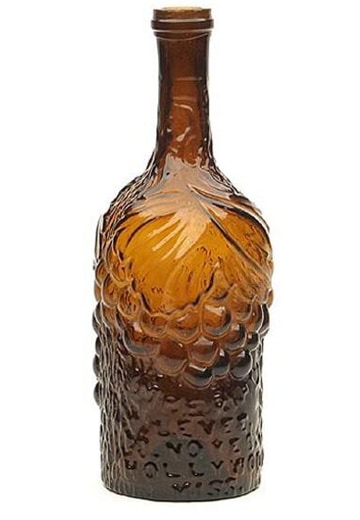 An absolute favorite bottle of mine is the ‘Imperial / Levee / J. Noyes / Hollywood / Miss.‘ figural wine bottle. This bottle comes embossed with the typography noted above and un-embossed. The bottle was made somewhere between 1845 and 1860 and is in the form of a cluster of grapes and grape leaves on a stump. It has an applied mouth with ring and an iron pontil mark. This is a beautiful and very fancy bottle and is probably the finest Mississippi bottle in form, color and age. Most examples are amber, with only a few known in cobalt.
An absolute favorite bottle of mine is the ‘Imperial / Levee / J. Noyes / Hollywood / Miss.‘ figural wine bottle. This bottle comes embossed with the typography noted above and un-embossed. The bottle was made somewhere between 1845 and 1860 and is in the form of a cluster of grapes and grape leaves on a stump. It has an applied mouth with ring and an iron pontil mark. This is a beautiful and very fancy bottle and is probably the finest Mississippi bottle in form, color and age. Most examples are amber, with only a few known in cobalt.
Updated information 13 June 2012: James Noyes – Hollywood, Mississippi & the Imperial Levee
Updated 13 June 2012: Hollywood is the name of the Noyes plantation near Natchez, Mississippi. Hollywood does not refer to Hollywood, Mississippi.
An absolute killer example of this bottle was posted by advanced collector, Charles Aprill on my facebook page a few nights ago per my request. You see, though I have not met Charles, he is a legendary collector of blue bottles and glass. We even spoke once, years ago, about my blue fish. The picture is posted below with a few comments from Charles.
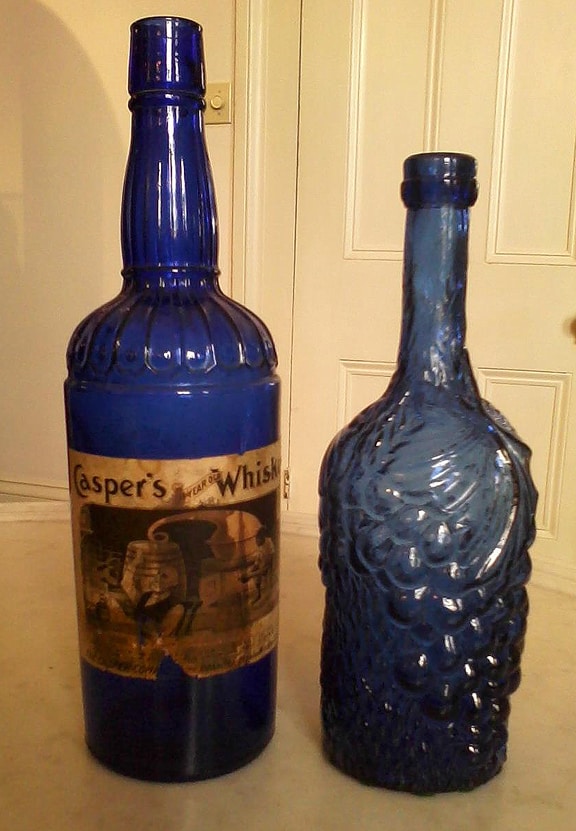
The Casper's Whiskey is for size comparison. The blue on the right is unembossed, but otherwise identical to the famous amber Mississippi whiskey - Aprill Collection
[Charles Aprill describing the bottle] The top and bottom of the bottle are of thicker glass and qualify as “cobalt blue”. The middle, about the grape clusters is thinner glass and is “sapphire”. This bottle is extremely light in weight, surprisingly so. The camera settings are off. The background is a white wall and door, the bottles are sitting on a white marble top table.
[Charles Aprill discussing how he obtained the bottle] I got a Polaroid photo of this blue one, which we kept on the refrigerator for about 25 years. The owner was not identified and the dealer wouldn’t left me know who it was. Just a tiny tease. Suddenly I was informed he wanted to sell. I jumped and it has had a happy home for the last 10 years or so.
One of the rarest of the Imperial Levee bottles (pictured above) was this 10″ Figural Cluster of Grapes on a Stump in cobalt blue sold on eBay in 2005 for $18,800. I have owned two or three unembossed examples over the years and have added a few pictures below. I think I will put Charles’ blue example on my refrigerator door for good luck!

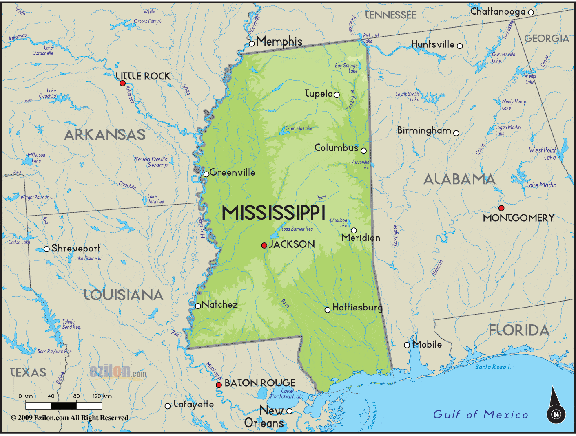

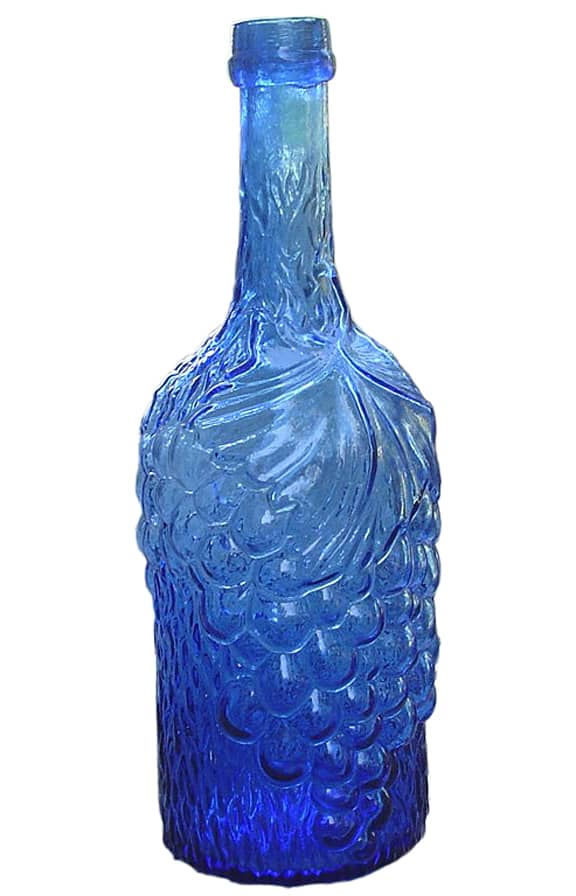
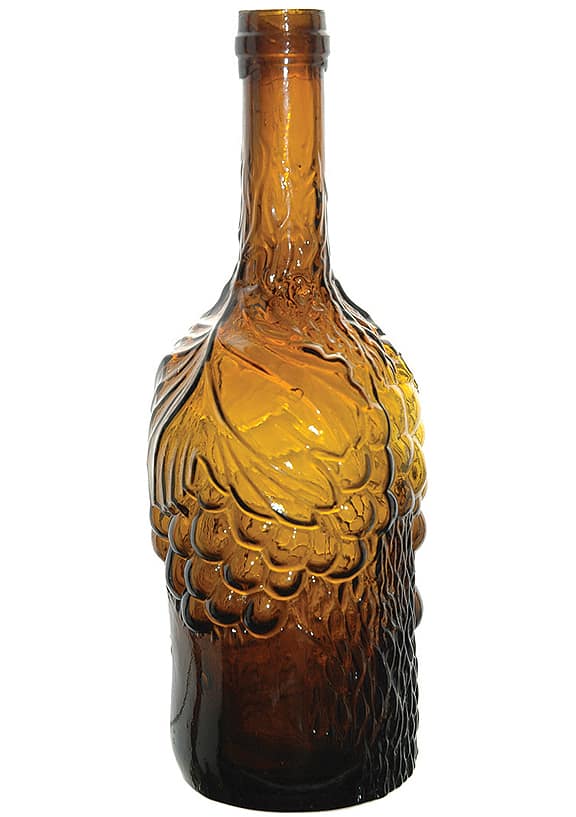
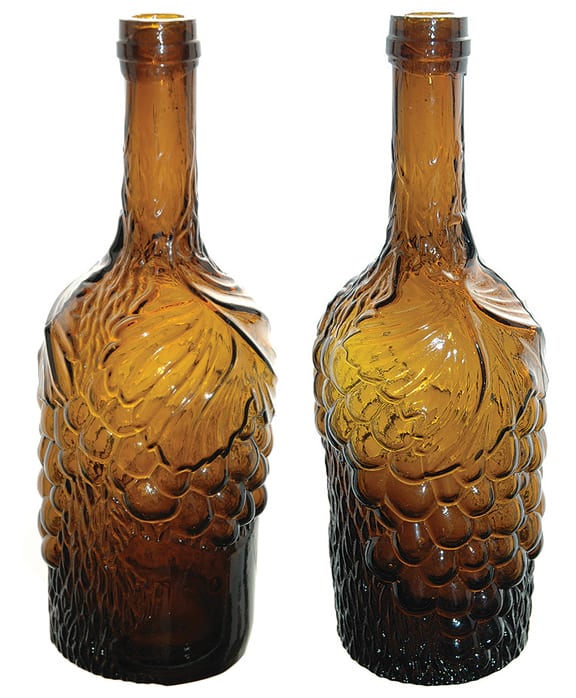
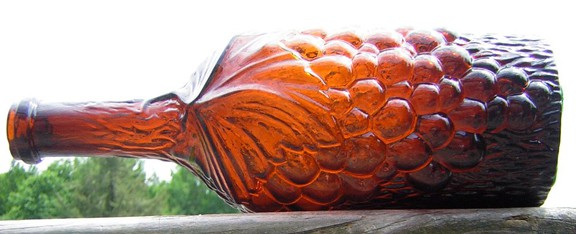










Hey Ferdinand, on the subject of blue bottles, I wonder if you have been following the blue cathedral pickle that just went off on ebay? As an ex-pickle bottle collector, I have been watching this with keen interest. In a somewhat common form ( four sided with crosshatched panels ), this pickle includes a rare expanded mouth and a color which rarely, if ever, is found in a cathedral pickle. I would describe this color as a light sapphire or dark cornflower blue, but I suppopse there may be other better descriptions. Anyway, without a doubt it is totally unique in my opinion and one of the most spectacular cathedral pickles out there. Congratulations to the winning bidder, and I hope that it will show up at the Reno Expo for viewing! Oh yes, final hammer price a cool $16,200. Item #230778721478.
Dennis Rogers
Yes, I had been watching that but forgot about it. Would you please send me the link? Thanks
Ferdinand,
The J. Noyes bottle is from Hollywood Plantation which was located outside of Natchez, Miss. not from the small community in north Mississippi near Tunica. A very informative article was written about J. Noyes and his wine bottles some 10-20 years ago by two of the more advanced Mississippi bottle and jug collectors at the time – George Chatham and Sim Callon. The article was published in one of the bottle magazines which I want to recall may have been Antique Bottle and Glass Collector. I will see if I can locate a copy of that article and forward it to you.
Apparently, J. Noyes was a highly educated and very wealthy planter as well as a wine connosuier. I did locate one of the resource references that George and Sim utilized when they wrote their article on J. Noyes. It comes from Debow’s Review, Agricultural, Commercial, Industrial Progress and Resources – a trade periodical of the time – and relates to making wines in the South. There is a very lengthy letter from J. Noyes dated July 25, 1848 to the editor, J.D.B. DeBow, about the intricasies of growing grapes and making wine in antebellum Mississippi. I have attached a transcription of the DeBow’s write up below.
Regards,
Justin
From Debow’s:
We have on frequent occasions, in the 2d, 3d, 4th, and 5th volumes of the Commercial Review, referred elaborately to the product and manufacture of wines in our own country, and furnished full and elaborate papers from various sources upon the subject. Our desire has ever been to present the matter with the utmost fullness and fairness. In this view we publish the following letter. In regard to the specimen bottles of wine referred to by our friend, which he kindly forwarded to our address, we received and discussed them. Nothing could be conceived more exquisite than the flavor it possesses; and a gentleman who has travelled extensively in Europe, to whom we generously accorded a few sips of the nectar, conceived that nothing he has met with upon the Rhine could compare with it! He was in ecstasy. So were we. Our friend, Mr. Weller of North Carolina, sent us some time ago, several delightful specimens from his vineyard, and we well remember the pleasure with which a party of our friends, on the Fourth of July, decanted glass after glass, to the health of the “old North State,” and her neighbor to the southward.
J. D. B. DeBow, Esq.: As I am deeply interested in the prosperity of the vine culture of the South, and seeing an article in your number for January last that tends to create a strong dislike to the use of wine, I have at length thought proper to correct it, and in doing so, I wish you to understand that I do not attach the slightest blame to yourself. The article in question I wish to refer you to, is on the 25th page of your January number, 1848, headed “American wines and vines.” Mr. S. Weller, of Carolina, states that a good wine cannot be made without the aid of three pounds of sugar per gallon, or one-third part of spirits. Now I have no doubt as to Mr. Weller’s statements being strictly correct, as far as his experience in that climate and in the section of country in which he resides goes. As I have had the advantage of some years’ correspondence with Mr. Weller, I have formed a very high opinion of him as a vintner; but his statistics for the Carolinas, when applied to our warmer states, will have no application. When he sees from the following the superior quality of fruit produced here from the same grape he cultivates in Carolina, he must readily account for the different results I am about to show in the manufacturing of wine in Mississippi. I have sent you two small bottles of this wine that you may examine it, in company with two or three of the best judges of your acquaintance, and make what remarks you think best upon it. The opinion entertained by myself and friends here of this wine, is exceedingly flattering. We believe it possesses the qualities of three of the finest wines in the world, namely, Champagne, Muscat and Hock, (3 parts of the first named, 2 parts of the second, and 1 of the last named wines.) A very small quantity of sugar was put into this, and I think it would have been much better without. Not one particle of spirits of any kind whatever has been mixed with it, and I think the smallest portion would have destroyed its delicacy and piquant force so desirable to connoisseurs. By the bye, I am saying too much myself about this wine when seeking the opinion of others; but I hope to have the opinion of yourself and friends entirely apart from all that I have said. One thing more I must say with regard to its condition; it was made last September-was only six months in cask, (instead of two years,) and has been but four months in bottle, when it ought to have been a year before it was examined; you will make every allowance for such disadvantages, of course. While my object in writing you this letter is to remove the unfavorable impression Mr. Weller’s letter must have made on the public, I wish also to say a few words upon the culture and the extension of the wine cause. We shall soon find in this country, as they have so long found it in Europe, that some neighborhoods are famous for wines, for richness and delicacy of flavor, that no other wines can equal. As they cannot be transported to any great distance without the aid of spirits, we must be deprived of their use. This wine, though so lusciously delicate, possesses a body of the stronger conserve, and will allow of being transported to any inland distance when properly packed; but to enjoy all its qualities, the growth will have to be confined to a few of our Southern states, such as this state, Louisiana, Alabama and the Floridas. As it would be vain in me to mark out a course of habits and a form of diet followed by any one nation, and rigidly enforce it to the use of all, so it would be equally vain to recommend the plan of culture of one kind of grape to be adopted for all, or that of one climate in the states to be followed in all the Union. I shall therefore confine myself to a course of culture necessary to be applied to the grape I have adopted in my vineyards, and the treatment I conceive to be best in the states above named. After failing in upwards of fifty varieties, and abandoning them as useless, I have selected one called the Roanoke, and known by that name from the time it was discovered on the island of Roanoke down to a recent period, when it took the foolish name of Scuppernong, which it now holds in the Carolinas. I have made three different kinds of wine from this grape last year, and all equally good, although differing in flavor and color so much, that no one could judge they were made from the same fruit. The Greeks call this grape the Flearic, and insist upon it as the one from which they make the choicest wines of that country. A Greek gentleman of my acquaintance in Natchez, last summer, in company with a countryman of his, paid me a visit for the first time, to see my vineyard. The fruit was not then ripe; but the moment he fixed his eyes on the grape, he recognized it as an old friend. He told me more of its properties as a wine grape than I have been able to learn from any other source; and the information I derived from him was of much use to me during my last vintage, and also at the bottling of the wine last spring. I think it pretty certain that this grape is a native of a very different climate than Carolina, as it does so much better in this climate. The following facts go much to show this, as I cannot claim, as the result of management, all the difference produced here. Climate must be important. A writer on this grape in that country about 25 years since, gave a very excellent description of it. He stated that the size of the berries did not exceed more than 2, inches round, and in weight not exceeding 82 grains. Now it is common for me to have fruit to measure 31 inches round, and at times more, and weigh 150 grains to the single berry. The fruit has always been ripe here the last of August, long before the hot weather has subsided, giving every chance to the grape to acquire all the saccharine so essential to strength and body. Thus the wine does not require the aid of sugar or the smallest particle of spirits to give it conserve. It is not so in Carolina. There it does not mature its fruit until October, and by that time its maturity is checked by more or less cold weather, and, as Mr. Weller says, about a fourth, or if a strong wine be wanted, a third of good spirits must be mixed with the juice. Now the admixture of spirits destroys the delightful bouquet and piquant force that characterizes the wine I have sent you, and, in fact, all the wines I have ever made here. The treatment I pursue in the culture of this grape is different from that used in all other kinds. I apply no summer pruning whatever, other than to tic up all the branches of a growth in order to prevent the ill effects of wind. At the first planting I set out well rooted plants of one season’s growth from layers, as this grape will not grow from cuttings. These are planted twenty feet apart, in straight lines, attached to a stake five feet high. As soon as they shed their leaves in the fall, all the tendrils or claspers they have made must be removed, except those that take hold of the stake; for if any are allowed to remain clasping their own branches a second year, the branch will die above the grasp, as the claspers will have ceased to grow and become as hard as wire. On the first dry weather, late in December or early in January, I cut off all branches that may be in the way the next season, and all dead wood, if any, and any tendrils found clasping a branch that may have escaped notice before. In removing the branches, I take care to cut close to the stem from which they are taken, as the bark will then slip over more readily when it begins to grow. These operations close the first season. I commence the second by driving down additional stakes on each side, in a straight line with the first, at proper distances to receive the lateral or side branches that have been formed. I then nail across, in a horizontal line, and about nine inches apart, cane poles to receive the small upright branches of the next season’s growth-at all times taking care to keep the mother or main stem upright at the centre stake, and adding to the height of that stake as often as it requires. After this work is performed – which we call dressing – I proceed to hoe and rake the ground about the vines, regarding it unnecessary to clean or plough the whole of the vineyard until the third or fourth year, since the roots will not extend from plant to plant until after that time. I proceed the third season in the same manner as the second, adding stake behind stake, in a straight line, and poles, until the vines, planted twenty feet apart, touch each other. This kind of trellis training is cheapest and much the best until the vineyard has established a good growth. A cheap arbor can then be erected by setting up strong rough posts eight or ten feet high, and throwing rough rails from post to post. Cane poles may then be placed across for the vines to run on. From year to year extend the growth at the top, and diminish that below, by cutting out the lower branches. This plan will tend to give a moderate excitement in the circulation of the sap, as well as to improve the fructifying powers of the plant. I am not sufficiently acquainted with chemistry to be able to give a proper description of the soil of my vineyard, but, as far as I can judge, it is principally composed of a light yellow loam with a small quantity of sand, and a still smaller portion of lime. But whatever may be its quality, thousands of acres lie almost abandoned as useless, having been exhausted by the constant succession of crops of corn and cotton. I do not pretend that this worn-out land is exactly fitted for the reception of the grape in its present condition, but all it requires is a small portion of sand and rotten log, or black soil, or stable manure, mixed up and spaded in well with the natural soil, in the places where each vine is planted. This gives it a start, and it will soon find the way into the natural soil and thrive in it, by the aid of the smallest portion of compost raked into the surface every fall. Inquiries are often made in regard to the probable profits of a vineyard; and as mine are too young to estimate by as yet, I would prefer not to give an opinion, but refer all inquirers to Mr. Weller’s letter to which I have alluded. [* See Commercial Review, vol. V, pp. 28-9, 203] No one can be better qualified than that gentleman to give an opinion. I promised to say something on the extension of the wine cause in this neighborhood. My success has already given such a different coloring to the wine business here, that three new vineyards are to be planted out next fall within three miles of my place; and I am willing to wager that there will be twenty planted in this county within the next five years, though there are now only two in existence, and these owned by myself. As soon as it is believed that a grape has been found that will produce a crop every year, the business will make most rapid strides. I have several orders on my books already for wines next fall, and I shall only be able to supply from three to four hundred flasks after supplying my own wants. As many persons inquiring about the profits of the wine business will not be able to see Mr. Weller’s letter, it may be well, perhaps, to notice part of it here. He states various results from his own experience as well as from that of others, and a profit of $2,000 per acre is among the lowest. These estimates may appear high to some persons, but I think $2,000 profit per acre from a vineyard in the south at 12 years old, a very fair estimate from the grape mine is planted with.* Yours respectfully, J. NOYES. * Hollywood, Natchez, Miss., July 25, 1848
Justin….now this is JUST what I am talking about. Thank you so very much for your valuable time and addition to this post that is now archived for all to see
.
Ferd, as someone who owns one of your ex unembossed Imperial Levee bottles (purchased from you at the Baltimore show several years ago), I agree that it’s a very interesting type, and one of my favorite forms. I’ve always wondered what product it held. It’s usually classified as a whiskey but I’ve not seen one with a label and I’m not sure a labelled example exists. The Glass Works Auction 74 (June 2005) had three outstanding examples including an unembossed cobalt one that fetched $29,120 with the buyer’s fee.
Yes Mike…when I did this post today I saw my records and your name. I remember. What a great bottle.
I, too, own one of the amber examples that I purchased at Baltimore several years ago. In my opinion it is a great bottle that fits nicely in among my figural bitters and whiskeys.
Bob Ferraro